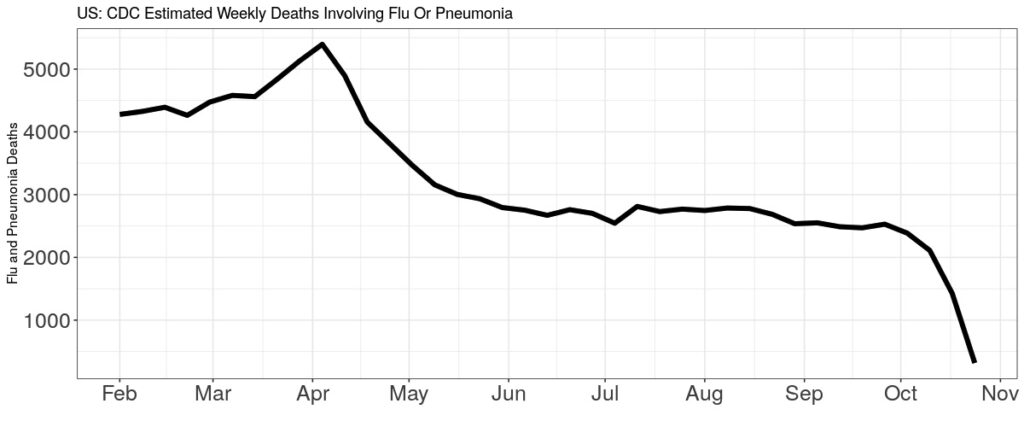What’s Happened to the Flu?

In 2020, the flu seems to have gone missing.
The flu, and the subsequent pneumonia that often accompanies it, count for 5-12% of all weekly deaths, each and every week, each and every year. So, all things being equal, this would be terrific news. If it’s true.
The CDC tracks weekly flu samples from public health labs across the country. During the week of October 12, 2020, there were 3,071 tests conducted and the results sent to the CDC. Only one tested positive for flu. Even stranger, in the 17,012 cumulative samples taken since September 27, only 5, or 0.03%, were positive.

The CDC also collects tests from private clinical laboratories. During the week of October 12, 10,809 tests were conducted, of which of just 33 were positive for flu. As of September 27, 35,688 tests were conducted, and only 121, or 0.3%, were positive.
COVID Up, Flu Down
What’s happening? It’s not that the number of tests is unusually small. This level of sampling is average. But the number coming back positive is much smaller than normal. Usual levels are about 2 to 3% positives at clinical labs and 6% to 19% at public health labs. This year it’s only 0.03%–0.3%!
Now, samples testing positive for flu were high at the beginning of 2020, as usual. But positive tests soon dropped. By the week ending April 5, they almost completely disappeared. They’re still gone.
This April date, of course, coincides with the peak of the coronavirus pandemic.
The CDC estimated there were 24,000 to 62,000 flu deaths from October 1, 2019, through April 4, 2020. These numbers are a bit on the low side for a flu season, but not atypical.
How many flu deaths have there been since April 4? The CDC does not say — anymore. They offer no information just on flu deaths, except in conjunction with COVID deaths. They say (in the same link) that in the week ending October 12, “7.6% of [all] deaths were attributed to pneumonia, influenza, or COVID-19.”
But they don’t trouble to break out how many of these were due to flu alone, pneumonia alone, or COVID-19 alone. The best they offer is to say that the flu has caused no pediatric deaths this season.
In the public statistics on weekly deaths, there are also no separate numbers for flu or pneumonia. Although there are for COVID-19.
Flu Goes Missing in Official Counts
The best we discern is that, as of October 28, there had been 212,328 deaths in 2020 “involving” (their word) COVID-19, and 339,473 deaths “involving” COVID-19 or flu and pneumonia. That means there are 127,415 deaths that presumably do not “involve” the coronavirus.
That 127,0000, if correct, would include the portion of 24 to 62 thousand flu deaths that occurred in 2020, and pneumonia deaths, too.
Up until September 20 of this year, the CDC maintained a separate database that tracked flu and pneumonia deaths separately, and also all deaths of any kind, beginning in late 2013 and continuing until September 20. The CDC has since removed the 2020 numbers from this database, though the weekly file is still being generated.
However, if we use the same subtraction “trick” as above, we can estimate weekly deaths involving flu and pneumonia, but not COVID-19. Doing that shows there have been roughly 2 to 3 thousand flu or pneumonia deaths every week since the end of May. But it’s impossible to specify the breakdown between these.
It’s not only the CDC seeing these curious flu numbers. It’s happening everywhere. The World Health Organization maintains a Global Influenza Surveillance and Response System, similar in scope and purpose to the CDC’s flu tracking.
All those parts of the world that submit flu tests have stopped reporting positive tests. Flu has gone missing from the WHO’s reports since early April, for instance, just as in the US. Positive tests are a fraction of where they are normally, with no signs of any increase at the start of the Northern Hemisphere flu season. This is bizarre.

What’s Happening?
We can think of three possible ways to explain this. First and most worrisome is that some (actual) flu and pneumonia cases are being mistaken for COVID-19. This could be due to the heightened sensitivity of the tests used to identify the coronavirus. But if this is true, then we will begin to see reports of more young people with deaths “involving” COVID-19. It will seem that the disease has switched from killing the elderly and infirm to the very young, since the flu tends to strike the very young and very old. This could incite new panic.
Second, perhaps the testing is accurate. Flu really has faded. That could be because the older people who would have succumbed to it instead died (or were reported as dying) of COVID-19. In other words, COVID-19 killed those who otherwise would have died from the flu, leaving fewer prospects for the flu to spread this year.
A third explanation: Perhaps only severe cases of flu are showing up on the tests. The weaker ones are showing up as the coronavirus. Or, rather, the coronavirus tests are everywhere taking precedence, and once they give a positive result, no flu test is performed.
Only time will tell us which of these scenarios, or some other one, is right. But clearly, our response to the coronavirus has made a mess of our usual way of tracking the flu.
William Briggs, Jay W. Richards, and Douglas Axe are the authors of The Price of Panic: How the Tyranny of Experts Turned a Pandemic into a Catastrophe.


